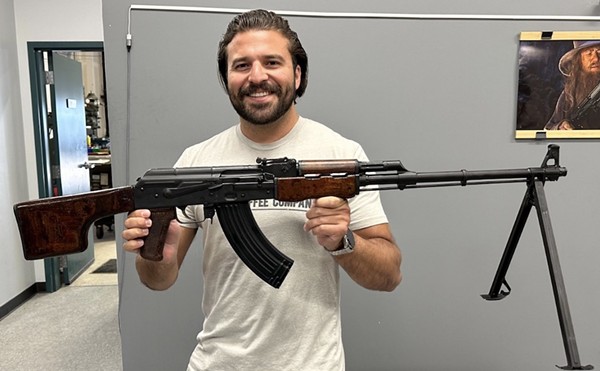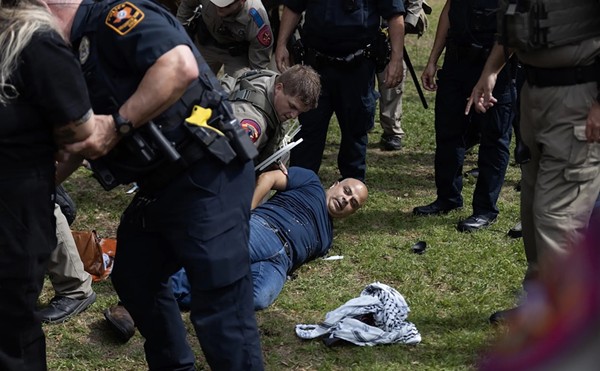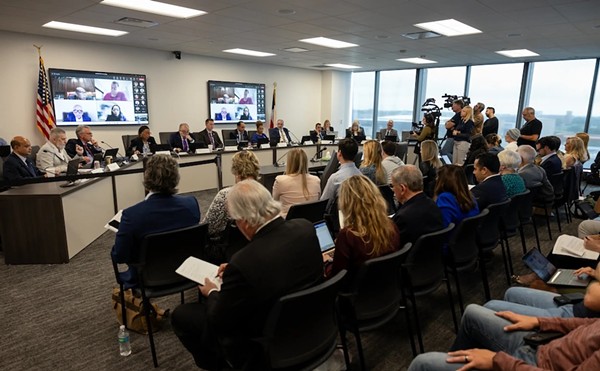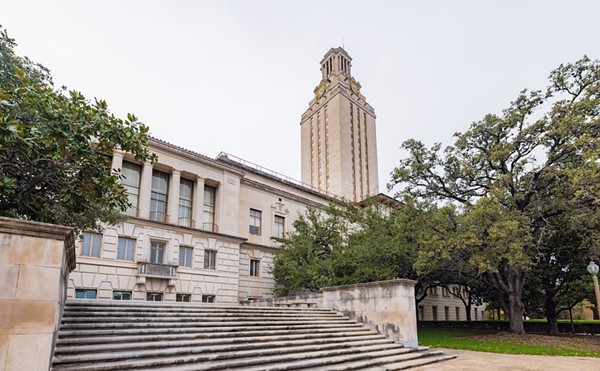Glitter Political: H. Drew Galloway cut his own path by encouraging young people to vote
By Jade Esteban Estrada on Wed, Dec 23, 2020 at 8:00 am
It’s an early Wednesday morning when H. Drew Galloway appears on my computer screen. A week has passed since he announced he’d be stepping down as executive director of voter mobilization group MOVE Texas to make way for new leadership.
After almost five years at the helm of the grassroots organization, he hopes to merge his passion for building statewide political infrastructure with his experience helping others understand and exercise their voting rights.
Though Galloway, 38, is well known in the Lone Star State’s progressive circles, the Georgia native’s political awakening occurred only eight years ago, while he was a member of Travis Park United Methodist Church.
“I attended a [Non-Discrimination Ordinance] meeting there and fell in love with the church,” he says. “Ultimately, that’s the community that taught me how to organize, show up and testify, and how to call through a list and get people to show up.”
In April 2016, Galloway’s skill set helped him get hired as the executive director of MOVE San Antonio, as the organization was known before its statewide expansion. Its moniker, then and now, is an acronym for Mobilize. Organize. Vote. Empower.
“It was just me and a field organizer and a couple of fellows,” Galloway says of the group’s 2016 election season. “We were small [and] scrappy.”
Months later, President Donald J. Trump’s policies — such as the travel ban, which affected international students at area universities — “sent shockwaves through the youth sector,” Galloway adds.
Concern over the administration’s agenda galvanized college students and helped transform MOVE over the next four years.
Today, MOVE Texas is staffed by 30 full-time employees. It also employed 45 part-time organizers ahead of the 2020 election.
“We’re in nine cities and over 65 campuses,” he says. “The volume of the work has exploded, especially this year.”
Galloway, who will leave in April, is proud of the space he’s helped create for new voters and up-and-coming leaders.
“Culturally, MOVE Texas has become a political home for young people across the state,” he says, adding that tapping into emotion is the first rung on the ladder of civic engagement.
I ask which emotion he means.
“Campaign lore says that there are two emotions that voters use: anger and [being] afraid,” he replies. “I think the great thing about working with young voters, particularly new voters, is that those voters are hopeful. We can really help craft this pathway for them around the issues that they care about to keep them engaged between elections.”
Despite an enthusiasm for voting Trump out of office, the Texas Democratic Party took a down-ballot beating on Election Day. When our conversation veers to the campaigns of MJ Hegar and Gina Ortiz Jones, who ran for Senate and the U.S. House, respectively, Galloway tells me he’s reminded of an activist who used the words “in the struggle” in her email signature.
“That always made me think about how the work never ends,” he says. “It’s always going to be there, it’s just our chance at doing the work.”
Galloway sees missed opportunities when candidates lose a race then shut down their website and disappear until six months before the next election cycle — if they come back at all.
“You have to ask yourself, ‘What did that campaign leave behind? What steppingstones did they leave for other organizers for 2022?’” he says. “I would argue that Beto O’Rourke is the only recent candidate that has built something out of a campaign that he ran. I don’t know if he won over Republican hearts and minds, but he at least had a conversation with them.”
I ask Galloway which three leaders he considers the rising stars of the progressive movement.
“Alex Birnel at MOVE Texas,” he says without hesitation. “Raven Douglas from the Center for Secure and Modern Elections and Rae Martinez, the director of Texas Rising.”
I ask Galloway how progressive is too progressive on the political spectrum for the average Texas voter.
“It makes me think of this saying, ‘We made the path by walking.’ [Progressive candidates] are these trailblazers, [even though] they might be on the fringe of the Overton Window when it comes to acceptable progressive policies,” he replies. “People like Bernie Sanders, Elizabeth Warren and Cristina Tzintzún Ramirez are making the path by walking it. And that means that they are not always going to be successful, and honestly, they may never be successful on a large scale, but they are lining up the next Alex Birnel, Raven Douglas or Rae Martinez to run for office and be successful.” He pauses for a moment. “You know I play bagpipes, right?”
I tell him I did.
“I am a hardcore competitor in the bagpipe world,” he says.
This year, Galloway ranked second in his grade for the Eastern United States Pipe Band Association, the largest piping organization outside of Scotland.
He shares the words of his bagpipe mentor: “It’s not about winning; it’s about playing every single time.”
When he competes, Galloway explains, he’s not worried about placing in the contest so much as showing the judge just how well he can play.
“I think about running for office in that way,” he says. “So, it’s not if Elizabeth Warren or Bernie Sanders won the presidency. It’s like, ‘Did they cut a path, and did they play?’”
A few days later, I meet Galloway for a photo shoot at Travis Park, across the street from the church that helped him turn his activism into a second career.
He explains that he once participated in a protest at the park demanding the removal of the Confederate statue once at the center of its green space.
“I still remember standing across the street at night watching the city pull that down,” he says proudly.
Galloway says Travis Park also reminds us that homeless people are part of the San Antonio community.
“So, when I see things like that bench over there, with the middle bar in there?” he asks, pointing. “That’s an intentional thing so that homeless people can’t lay on that bench. They instead have to come over here and lay on the stone or they have to lay on the ground.”
As we walk to the church, he says, “This reminds me that while we’ve come a long way, we still have a lot more work to do.”
Stay on top of San Antonio news and views. Sign up for our Weekly Headlines Newsletter.
After almost five years at the helm of the grassroots organization, he hopes to merge his passion for building statewide political infrastructure with his experience helping others understand and exercise their voting rights.
Though Galloway, 38, is well known in the Lone Star State’s progressive circles, the Georgia native’s political awakening occurred only eight years ago, while he was a member of Travis Park United Methodist Church.
“I attended a [Non-Discrimination Ordinance] meeting there and fell in love with the church,” he says. “Ultimately, that’s the community that taught me how to organize, show up and testify, and how to call through a list and get people to show up.”
In April 2016, Galloway’s skill set helped him get hired as the executive director of MOVE San Antonio, as the organization was known before its statewide expansion. Its moniker, then and now, is an acronym for Mobilize. Organize. Vote. Empower.
“It was just me and a field organizer and a couple of fellows,” Galloway says of the group’s 2016 election season. “We were small [and] scrappy.”
Months later, President Donald J. Trump’s policies — such as the travel ban, which affected international students at area universities — “sent shockwaves through the youth sector,” Galloway adds.
Concern over the administration’s agenda galvanized college students and helped transform MOVE over the next four years.
Today, MOVE Texas is staffed by 30 full-time employees. It also employed 45 part-time organizers ahead of the 2020 election.
“We’re in nine cities and over 65 campuses,” he says. “The volume of the work has exploded, especially this year.”
Galloway, who will leave in April, is proud of the space he’s helped create for new voters and up-and-coming leaders.
“Culturally, MOVE Texas has become a political home for young people across the state,” he says, adding that tapping into emotion is the first rung on the ladder of civic engagement.
I ask which emotion he means.
“Campaign lore says that there are two emotions that voters use: anger and [being] afraid,” he replies. “I think the great thing about working with young voters, particularly new voters, is that those voters are hopeful. We can really help craft this pathway for them around the issues that they care about to keep them engaged between elections.”
Despite an enthusiasm for voting Trump out of office, the Texas Democratic Party took a down-ballot beating on Election Day. When our conversation veers to the campaigns of MJ Hegar and Gina Ortiz Jones, who ran for Senate and the U.S. House, respectively, Galloway tells me he’s reminded of an activist who used the words “in the struggle” in her email signature.
“That always made me think about how the work never ends,” he says. “It’s always going to be there, it’s just our chance at doing the work.”
Galloway sees missed opportunities when candidates lose a race then shut down their website and disappear until six months before the next election cycle — if they come back at all.
“You have to ask yourself, ‘What did that campaign leave behind? What steppingstones did they leave for other organizers for 2022?’” he says. “I would argue that Beto O’Rourke is the only recent candidate that has built something out of a campaign that he ran. I don’t know if he won over Republican hearts and minds, but he at least had a conversation with them.”
I ask Galloway which three leaders he considers the rising stars of the progressive movement.
“Alex Birnel at MOVE Texas,” he says without hesitation. “Raven Douglas from the Center for Secure and Modern Elections and Rae Martinez, the director of Texas Rising.”
I ask Galloway how progressive is too progressive on the political spectrum for the average Texas voter.
“It makes me think of this saying, ‘We made the path by walking.’ [Progressive candidates] are these trailblazers, [even though] they might be on the fringe of the Overton Window when it comes to acceptable progressive policies,” he replies. “People like Bernie Sanders, Elizabeth Warren and Cristina Tzintzún Ramirez are making the path by walking it. And that means that they are not always going to be successful, and honestly, they may never be successful on a large scale, but they are lining up the next Alex Birnel, Raven Douglas or Rae Martinez to run for office and be successful.” He pauses for a moment. “You know I play bagpipes, right?”
I tell him I did.
“I am a hardcore competitor in the bagpipe world,” he says.
This year, Galloway ranked second in his grade for the Eastern United States Pipe Band Association, the largest piping organization outside of Scotland.
He shares the words of his bagpipe mentor: “It’s not about winning; it’s about playing every single time.”
When he competes, Galloway explains, he’s not worried about placing in the contest so much as showing the judge just how well he can play.
“I think about running for office in that way,” he says. “So, it’s not if Elizabeth Warren or Bernie Sanders won the presidency. It’s like, ‘Did they cut a path, and did they play?’”
A few days later, I meet Galloway for a photo shoot at Travis Park, across the street from the church that helped him turn his activism into a second career.
He explains that he once participated in a protest at the park demanding the removal of the Confederate statue once at the center of its green space.
“I still remember standing across the street at night watching the city pull that down,” he says proudly.
Galloway says Travis Park also reminds us that homeless people are part of the San Antonio community.
“So, when I see things like that bench over there, with the middle bar in there?” he asks, pointing. “That’s an intentional thing so that homeless people can’t lay on that bench. They instead have to come over here and lay on the stone or they have to lay on the ground.”
As we walk to the church, he says, “This reminds me that while we’ve come a long way, we still have a lot more work to do.”
Stay on top of San Antonio news and views. Sign up for our Weekly Headlines Newsletter.

KEEP SA CURRENT!
Since 1986, the SA Current has served as the free, independent voice of San Antonio, and we want to keep it that way.
Becoming an SA Current Supporter for as little as $5 a month allows us to continue offering readers access to our coverage of local news, food, nightlife, events, and culture with no paywalls.
Scroll to read more San Antonio News articles
Newsletters
Join SA Current Newsletters
Subscribe now to get the latest news delivered right to your inbox.


















